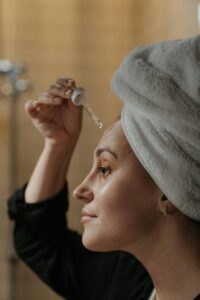Many different ways can be taken to rejuvenate the skin, each with its benefits and drawbacks. To make an educated selection, it is essential to have a solid grasp of the many anti-aging techniques available, whether your goal is to reduce the appearance of symptoms of aging, enhance the skin’s texture, or seem years younger.
This article will discuss the benefits and drawbacks of five of the most common methods to rejuvenate the skin. You can assess which choice is most in line with your aims and expectations by analyzing the pros and downsides of each approach and choosing the one that offers the greatest match.
1. Chemical Peels
Pros
- Chemical peels remove the top layer of skin and stimulate cell growth. It smooths and brightens skin. Reduces blemishes, discoloration, and sun damage for a more unified complexion.
- Chemical peels reduce aging. They minimize fine lines and wrinkles by boosting collagen formation and cell turnover.
- Chemical peels treat skin issues. They may minimize acne outbreaks, acne scars, hyperpigmentation, and skin tone. Chemical peels are adaptable skin health treatments that may address particular disorders.
Cons
- Chemical peels may cause redness, peeling, and sun sensitivity. Following post-treatment care recommendations and avoiding sun exposure can help these symptoms fade within a few days to two weeks.
- Chemical peels seldom cause side effects. Sensitive skin may cause severe redness, swelling, and blistering. A specialist must examine skin adaptability and determine the right peel kind and strength.
- Chemical peels may need downtime and rehabilitation. Peeling, redness, and sensitivity may occur throughout the recovery phase after deeper peels. This may necessitate changes to regular habits and activities for optimum recovery.
2. Microdermabrasion
Pros
- Microdermabrasion removes dead skin cells. This technique smooths and evens skin. It also reveals fresh, healthy skin for a youthful shine.
- Microdermabrasion is painless and non-invasive. Most people feel a little itching or tingling during the operation, which is harmless.
- It can help stimulate collagen production, leading to improved skin texture, reduced fine lines, and diminished acne scars.
Cons
- Achieving desired results often requires multiple sessions spaced several weeks apart, which can be time-consuming.
- Microdermabrasion may make the skin irritated and red. These symptoms normally fade within hours or days. Avoiding sun exposure and using moderate skincare products after treatment reduces unwanted effects.
3. Laser Resurfacing
Pros
- Laser resurfacing pinpoints skin issues. The laser strength and depth may be adjusted to treat a variety of skin conditions. Each person’s skin type and concerns may be addressed to get the best outcomes.
- Laser resurfacing improves skin long-term. Many people experience smoother, firmer, and younger-looking skin for a long time due to collagen stimulation and skin structure remodeling.
Cons
- Laser resurfacing makes skin sun-sensitive. To avoid hyperpigmentation and other problems, cover the treated region from direct sun exposure and wear sunscreen daily. Post-treatment care must be followed for the best healing and outcomes.
- Laser resurfacing involves a long recovery period. After treatment, the skin may be red, inflamed, and peel or crust. Skin may take weeks to heal, depending on treatment severity. Doctors should provide patients with post-treatment care advice.
4. Dermal Fillers
Pros
- Dermal fillers can help enhance and restore facial contours. They can be used to add volume to areas such as the cheeks, temples, and jawline, providing a more defined and balanced appearance.
- Dermal filler treatments are minimally invasive, involving simple injections into the targeted areas. The results are often visible immediately, with further improvement over the following days as the filler settles. There is no need for surgery or significant downtime.
Cons
- Fillers are temporary. The body absorbs the injected filler over time, restoring the treated region. Maintenance treatments usually maintain results.
- Fillers may be costly. Cost depends on filler type, volume, number of treatment sites, and injector skill. For best results, many treatments may be needed, increasing expense.
5. Micro-Needling
Pros
- When paired with the cutting-edge technology of Sylfirm X, micro-needling stimulates the production of collagen and elastin in the skin, resulting in improved skin texture and firmness. It reduces acne scars, fine lines, wrinkles, and hyperpigmentation, making skin smoother and younger.
- Micro-needling may be done on the face, neck, and hands. It may be tailored for various skin types.
- Micro-needling creates micro-channels that improve skincare product absorption. Serums and creams may penetrate deeper, boosting their efficacy.
Cons
- Micro-needling causes redness, edema, and minor discomfort. These adverse effects usually disappear within a few days. Aftercare, including moderate skincare and sun protection, reduces these transient effects.
- Micro-needling is usually done in series. The number of sessions depends on the skin state and intended goal. Significant gains need patience and dedication to the prescribed treatment approach.
Conclusion
To choose the most appropriate strategy for skin rejuvenation, one must carefully analyze the benefits and drawbacks of each procedure. The procedures of chemical peels, microdermabrasion, laser resurfacing, dermal fillers, and micro-needling have advantages and potential drawbacks. It is important to discuss your unique requirements with an expert to ascertain which of the options is the best fit for your circumstances. By thoroughly assessing the benefits and limitations of each method, you can make an informed decision that ensures a safe and effective skin rejuvenation experience tailored to your requirements.


